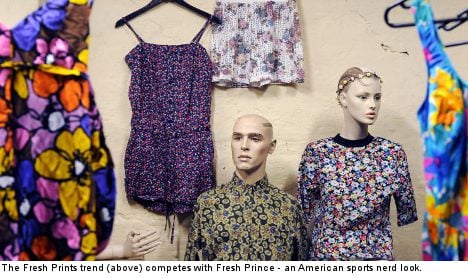The concrete ramp down to the basement stores is guarded by mannequins all decked out in black and white. Monochrome is a big runway trend easily translated by picking up second hand gems, but the fresh breeze from the street outside even make the dolls look like they are shivering.
“We even sold a fur coat last week,” says Beyond Retro store manager Niklas Lundqvist.
He himself is wearing what he terms an amalgamation of three current trends for men: plateau boots, monochrome (his black and white trousers have vertical stripes), and a Los Angeles Kings sweatshirt.
“Fresh Prince of Bel Air is all the rage for vintage enthusiasts, we can’t seem to stock enough sweatshirts at the moment,” says Lundqvist, gently tugging at the sleeve of a forest green number.
He encourages trend-sensitive men to take cues from seasonal women’s wear and interpret it, as mainstream male fashion is more detail-orientated. The five trends he has selected – Fresh Prince, Luxury Grunge, Monochrome, Denim, and Fresh Prints – can all be unisex.
IN PICTURES Five trends for Swedish spring
“I realized I got to the age where I am now seeing a trend hit hard three times,” Lundqvist says. “I used to borrow my big sister’s workout gear in the eighties and wear it.”
The eighties’ Flash Dance era when leggings were de rigeur teamed with an oversize sweater did fizzle out, only to re-emerge in the nineties in the shape of the nerdy sports team cult. Not only Sporty Spice in her side-stripe sweatpants, but all things American, all very much in the spirit of the Fresh Prince of Bel Air television show starring Will Smith.
It was not uncommon for Swedish teenagers at the time to wear sweatshirts with the names of US baseball, football or hockey teams. Lundqvist dishes up the Anaheim Mighty Ducks logo as an example, but says that names of Swedish teams is a strict no no.
“Seriously, you wanna wear Modo on your chest?” he says, referencing the Swedish ice hockey team. The Americana trends stretches to baseball caps.
“My guy friends and I spend a lot of time on eBay scouting for good ones,” says Lundqvist, who is a former fashion trend spotter for the tabloid Aftonbladet.
And while in the nineties, let’s look at another current revamp. Luxury Grunge – in essence re-introduced by Dries van Noten’s much-lauded spring/summer collection where models combined checked shirts with exclusive fabrics, such as a silver lamé pencil skirt. Saint Laurent sported a similar but less audacious take one season later at the recent Paris shows.
Original grunge, as many may remember, was rather unkempt. That didn’t stop melancholic teens of the epoch from latching onto Nirvana front man Kurt Cobain’s untimely demise and, sartorially at least, join the throngs of true fans.
In short, imagine giving Courtney Love a bath and sending her to finishing school. Rather uninspiring as a social experiment, but old standard in terms of current trends. Wearing your jeans until they split at the knee is optional.
Denim, however, is not optional. Rather than a trend, it’s a staple, and Lundqvist points out that while the big fashion magazines may go wild over a specific cut or dye depending on the season, vintage customers are comfortable referencing different eras.
The diversity stretches to another staple that comes and goes in waves – Fresh prints stretching from preppy to psychedelic. Lundqvist doesn’t want to classify it as floral, and hangs up both a lime-green paisley shirt and a shirt that tends to the eighties, that in fact merges a bit with the Fresh Prince trend. There is also, however, both Mayan-inspired prints and finer clusters of small flowers that draw comparisons to the classic Liberty prints.
Lundqvist unearths a shirt that screams Chandler Bing from the television series Friends, early Friends. It would make many a man run for the forest.
“It doesn’t matter what print it is,” says Lundqvist. “Every print sells.”
Ann Törnkvist




 Please whitelist us to continue reading.
Please whitelist us to continue reading.
Member comments